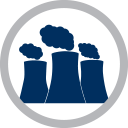What is nuclear and radiological security?
Nuclear and radiological security aims to ensure nuclear and other radioactive materials are secure from unauthorized access and theft, and that nuclear facilities are secure from sabotage. There are three primary components to nuclear and radiological security – physical security, operational security, and accounting. [i]
- Physical security measures, commonly referred to as “gates, guards, guns,” seek to accomplish the “Five Ds” of nuclear security, to “deter, detect, delay, deny, and defeat” threats [ii]
- Operational security focuses on human behavior—establishing and reinforcing security-conscious personnel conduct. An important element of operational security are measures to vet the reliability and trustworthiness of personnel with access to nuclear facilities to mitigate the risk that authorized personnel, or insiders, could perform acts of theft or sabotage and potentially aid terrorists or criminals
- Control and Accounting measures enable the rapid detection of unauthorized events such as the theft of nuclear material, and can provide the timely and accurate information necessary to catching perpetrators [iii]
These three components are highly interdependent. For example, physical security measures at a facility are only as effective as the operational security culture underpinning them; if personnel at a facility leave gates to restricted areas unlocked, physical security measures become useless. In the words of General Eugene Habiger, “good security is 20 percent equipment and 80 percent culture.” [iv]
Why is nuclear and radiological security important?
Maintaining effective nuclear and radiological security is vital to mitigating terrorist, criminal, and insider threats.
-

Terrorist groups might use or threaten to use a nuclear explosive device or radiological device, or sabotage a nuclear power plant for political or ideological reasons
-

Criminal organizations or individuals might illicitly sell nuclear or other radioactive materials for profit, or extort money by threatening an attack
-

Insiders working at nuclear facilities, and motivated by greed, sympathy, coercion, or animosity towards management, could perpetrate thefts or sabotage, or assist terrorists or criminals in gaining access to materials and facilities
Acquiring the necessary material would likely be the most difficult step faced by a terrorist group interested in carrying out a nuclear or radiological attack. [v]
Because nuclear and other radioactive materials are used worldwide in support of both civil and military activities, providing adequate security for all of these materials is an especially serious challenge:
Some nuclear and other radioactive materials are poorly secured and vulnerable to theft. For example:
 Some facilities housing nuclear material do not have armed guards on site, and instead plan to rely on local security forces in the event of an attack [xi]
Some facilities housing nuclear material do not have armed guards on site, and instead plan to rely on local security forces in the event of an attack [xi] In most countries armed personnel are not required to protect transports of even the most dangerous radioactive sources [xii]
In most countries armed personnel are not required to protect transports of even the most dangerous radioactive sources [xii] Some countries do not require protections against insider threats at material storage sites or nuclear power plants [xiii]
Some countries do not require protections against insider threats at material storage sites or nuclear power plants [xiii] Weapons-usable nuclear and other radioactive material has already been lost or stolen, and is therefore potentially available to terrorists [xiv]
Weapons-usable nuclear and other radioactive material has already been lost or stolen, and is therefore potentially available to terrorists [xiv]
How do nuclear security and nuclear safety differ?
Both nuclear security and nuclear safety prioritize preventing injury, loss of life, and harm to the environment, but respond to differing underlying causes.
- Safety measures aim to protect public health and minimize potential harmful effects of nuclear activities to people or the environment, such as by ensuring safe reactor operations to prevent an accident [xv]
- Security measures aim to prevent intentional or malicious acts, such as theft of or unauthorized access to nuclear or other radioactive materials as well as sabotage of nuclear facilities
Security and safety measures can work in concert or at odds with each other: [xvi]
- Restricted areas can prevent someone from inadvertently wandering into a room with dangerous radiation levels (safety), while simultaneously preventing or delaying sabotage or theft of materials (security) [xvii]
- However, too much access control for security purposes can also delay emergency responses. [xviii] For example, defensive barriers designed to delay an attack could impede firefighters or obstruct evacuation routes in the event of an accident [xix]
- Because it is not always possible to rapidly distinguish deliberate sabotage from an accident, facility-specific solutions to minimize overall risk are required [xx]
What is the role of the state in nuclear and radiological security?
States can and do play a critical role in nuclear and radiological security by:
- Enacting laws and regulations that set security requirements for nuclear facility operators and their facilities [xxi]
- Establishing an independent regulatory agency with sufficient authority and resources to provide oversight and hold the state’s nuclear enterprise accountable
- Sharing information with operators about possible threats to facilities
- Taking actions to build confidence in the effectiveness of their security, such as publishing relevant laws and regulations or annual reports
- Enacting laws that criminalize and set appropriate penalties for theft and attempted theft of nuclear and other radioactive materials, as well as acts of nuclear and radiological terrorism
- Recovering lost or stolen nuclear or other radioactive material
- Installing radiation detectors at border crossings and seaports to deter and interdict illicit trafficking in nuclear and other radioactive materials
- Conducting intelligence and law enforcement operations to identify and disrupt individuals or groups intent on supporting or committing acts of nuclear or radiological terrorism.
Even states that do not possess weapons-usable material play a vital role in nuclear security, “because they, too, have a responsibility not to become safe havens, staging grounds, or transit points for illicit nuclear activities.” [xxii]
What is the role of industry and the nuclear operator in nuclear and radiological security?
Since private industries operate many facilities where nuclear and other radioactive materials are present, and are often responsible for its transportation, they represent the first line of defense against theft or sabotage.
Key actions industry can take to ensure effective security include: [xxiii]
- Compliance with state laws and regulations
- Continual self-assessment of facilities’ abilities to cope with safety and security threats
- Participating in peer review of security practices
- Training and certifying personnel responsible for security related tasks
- Building and continuously reinforcing a strong security culture
- Teaching and learning from other operators by participating in best practices exchanges and workshops
What is the international community doing to reduce the threat of nuclear and radiological terrorism?
Nuclear and radiological security is generally considered to be the responsibility of individual states, which set and enforce laws and regulations governing activities within their territories. [xxiv] Given the global implications of nuclear terrorism, however, all states have an interest in ensuring that nuclear weapons and weapons-usable materials are secure, and that all other states are meeting their security responsibilities.
- International concerns about nuclear terrorism first surfaced in the late 1970s, leading to the creation of the Convention on the Physical Protection of Nuclear Material (CPPNM)
- Following the collapse of the Soviet Union, nuclear security rose to the top of the U.S. national security agenda with the launch of the Nunn-Lugar Cooperative Threat Reduction Program, a U.S. government program designed to manage the risks posed by the disintegration of the Soviet nuclear weapons complex
- The terrorist attacks on September 11, 2001 increased global interest in strengthening nuclear security, and U.S.-led threat reduction programs began to expand beyond the Former Soviet Union. Major initiatives that emerged during this period include: the G8 Global Partnership Against the Spread of Weapons and Materials of Mass Destruction; UN Security Council Resolution 1540; the U.S. Global Threat Reduction Initiative (GTRI); the International Convention for the Suppression of Acts of Nuclear Terrorism (ICSANT); the Global Initiative to Combat Nuclear Terrorism (GICNT); and revisions to IAEA nuclear security recommendations and guidance documents
- In 2008, NTI launched the World Institute for Nuclear Security (WINS), a first-of-its-kind organization to provide a forum for those accountable for nuclear security to share and promote best practices
- In April 2009, U.S. President Obama declared the threat of nuclear terrorism to be “the most immediate and extreme threat to global security,” and called for “a new international effort to secure all vulnerable nuclear material.” [xxv] Subsequently the Nuclear Security Summit process has brought together over fifty world leaders every two years since 2010 to focus high-level attention on the threat of nuclear terrorism, and to agree upon an agenda for securing all vulnerable nuclear material
Numerous international initiatives address the dangers posed by unsecured nuclear and other radioactive materials around the world. These cooperative efforts have made significant progress towards:
- Building shared perceptions of the threat
- Strengthening and harmonizing security standards
- Consolidating nuclear weapons and weapons-usable material at fewer locations
- Minimizing the use of HEU in the civilian sector
Collectively, however, current international instruments and activities are insufficient to ensure that all nuclear weapons, weapons-usable materials, and major facilities will be effectively protected against terrorist and criminal threats. [xxvi]
Sources
[i] Committee on Indigenization of Programs to Prevent Leakage of Plutonium and Highly Enriched Uranium from Russian Facilities, Strengthening Long-Term Nuclear Security (Washington: The National Academies Press, 2006), p. 14.
[ii] Office of the Assistant Secretary of Defense for Nuclear, Chemical, and Biological Defense Programs, “Chapter 5: Nuclear Safety and Security,” The Nuclear Matters Handbook Expanded Edition, http://www.acq.osd.mil/ncbdp/nm/nm_book_5_11/chapter_5.htm.
[iii] Committee on Indigenization of Programs to Prevent Leakage of Plutonium and Highly Enriched Uranium from Russian Facilities, Strengthening Long-Term Nuclear Security (Washington: The National Academies Press, 2006), p. 6, 14, 27.
[iv] Prepared Statement of Dr. Matthew Bunn, U.S. Senate, Subcommittee of the Committee on Appropriations, “Energy and Water Development Appropriations for Fiscal Year 2009,” April 30, 2008, http://www.gpo.gov/fdsys/pkg/CHRG-110shrg79104333/html/CHRG-110shrg79104333.htm
[v] Sam Nunn, “Remarks at the Launch of the 2014 NTI Nuclear Materials Security Index,” National Press Club, Washington, DC, January 18, 2014, http://www.nti.org/analysis/speeches/remarks-launch-2014-nti-nuclear-materials-security-index/; Charles Ferguson and William Potter, The Four Faces of Nuclear Terrorism (Monterey: Center for Nonproliferation Studies, 2004), p. 271.
[vi] Hans M. Kristensen and Robert S. Norris, “Worldwide deployments of nuclear weapons, 2014,” Bulletin of the Atomic Scientists, Vol. 70, No. 5 (September/October 2014).
[vii] International Panel on Fissile Materials, “Global Fissile Material Report 2013: Increasing Transparency of Nuclear Warhead and Fissile Material Stocks as a Step toward Disarmament,” Seventh Annual Report of the International Panel on Fissile Materials, October 2013, p. 8, http://fissilematerials.org/library/gfmr13.pdf.
[viii] NTI Nuclear Materials Security Index: Building a Framework for Assurance, Accountability, and Action, Nuclear Threat Initiative, 2nd Edition, January 2014, p. 6, http://ntiindex.org/wp-content/uploads/2014/01/2014-NTI-Index-Report1.pdf.
[ix] “Q&A: Safety and Security of Radioactive Sources,” International Atomic Energy Agency, 10 March 2011, www.iaea.org.
[x] International Atomic Energy Agency, “The Database on Nuclear Power Reactors,” December 18, 2013, http://www.iaea.org/pris/.
[xi] NTI Nuclear Materials Security Index: Building a Framework for Assurance, Accountability, and Action, Nuclear Threat Initiative, 2nd Edition, January 2014, p. 7, http://ntiindex.org/wp-content/uploads/2014/01/2014-NTI-Index-Report1.pdf.
[xii] Tom Bielefeld, “Mexico’s stolen radiation source: It could happen here,” Bulletin of the Atomic Scientists, 23 January 2014, http://thebulletin.org/mexico%E2%80%99s-stolen-radiation-source-it-could-happen-here.
[xiii] NTI Nuclear Materials Security Index: Building a Framework for Assurance, Accountability, and Action, Nuclear Threat Initiative, 2nd Edition, January 2014, p. 7, http://ntiindex.org/wp-content/uploads/2014/01/2014-NTI-Index-Report1.pdf.
[xiv] Lyudmila Zaitseva, “Nuclear Trafficking: 20 Years in Review,” Contribution to the World Federation of Scientists Meeting, August 2010, p. 1; International Atomic Energy Agency, “Incident and Trafficking Database,” 24 April 2014.
[xv] “Behind the 2014 NTI Index,” NTI Nuclear Materials Index FAQ, http://ntiindex.org/behind-the-index/how-the-index-works/faqs/.
[xvi] International Nuclear Safety Group, International Atomic Energy Agency, “The Interface Between Safety and Security at Nuclear Power Plants,” INSAG-24, pp. 1-2, 15, 17-18, 21, http://www-pub.iaea.org/MTCD/publications/PDF/Pub1472_web.pdf.
[xvii] International Nuclear Safety Group, International Atomic Energy Agency, “The Interface Between Safety and Security at Nuclear Power Plants,” INSAG-24, p. 15, http://www-pub.iaea.org/MTCD/publications/PDF/Pub1472_web.pdf.
[xviii] International Nuclear Safety Group, International Atomic Energy Agency, “The Interface Between Safety and Security at Nuclear Power Plants,” INSAG-24, pp. 2, 15, http://www-pub.iaea.org/MTCD/publications/PDF/Pub1472_web.pdf.
[xix] International Nuclear Safety Group, International Atomic Energy Agency, “The Interface Between Safety and Security at Nuclear Power Plants,” INSAG-24, pp. 2, 4, 7, 13, 15, http://www-pub.iaea.org/MTCD/publications/PDF/Pub1472_web.pdf.
[xx] International Nuclear Safety Group, International Atomic Energy Agency, “The Interface Between Safety and Security at Nuclear Power Plants,” INSAG-24, p. 15, http://www-pub.iaea.org/MTCD/publications/PDF/Pub1472_web.pdf.
[xxi] International Atomic Energy Agency, “Objective and Essential Elements of a State’s Nuclear Security Regime,” IAEA Nuclear Security Series No. 20, p. 4-10, http://www-pub.iaea.org/MTCD/Publications/PDF/Pub1590_web.pdf.
[xxii] NTI Nuclear Materials Security Index: Building a Framework for Assurance, Accountability, and Action, Nuclear Threat Initiative, 2nd Edition, January 2014, p. 7, http://ntiindex.org/wp-content/uploads/2014/01/2014-NTI-Index-Report1.pdf.
[xxiii] NTI Nuclear Materials Security Index: Building a Framework for Assurance, Accountability, and Action, Nuclear Threat Initiative, 2nd Edition, January 2014, p. 53, http://ntiindex.org/wp-content/uploads/2014/01/2014-NTI-Index-Report1.pdf.
[xxiv] NTI Nuclear Materials Security Index: Building a Framework for Assurance, Accountability, and Action, Nuclear Threat Initiative, 2nd Edition, January 2014, p. 14, http://ntiindex.org/wp-content/uploads/2014/01/2014-NTI-Index-Report1.pdf.
[xxv] Office of the Press Secretary, “Remarks by President Barack Obama: Prague, Czech Republic,” The White House, April 5, 2009, http://www.whitehouse.gov/the_press_office/Remarks-By-President-Barack-Obama-In-Prague-As-Delivered.
[xxvi] Nuclear Threat Initiative, “The Need for a Strengthened Global Nuclear Security System,” Global Dialogue on Nuclear Security Priorities Non-Paper 1, November 19, 2012, http://www.nti.org/analysis/articles/non-paper-1-need-strengthened-global-nuclear-security-system/
 [vi]
[vi] [vii]
[vii] [viii]
[viii] [ix]
[ix] [x]
[x]